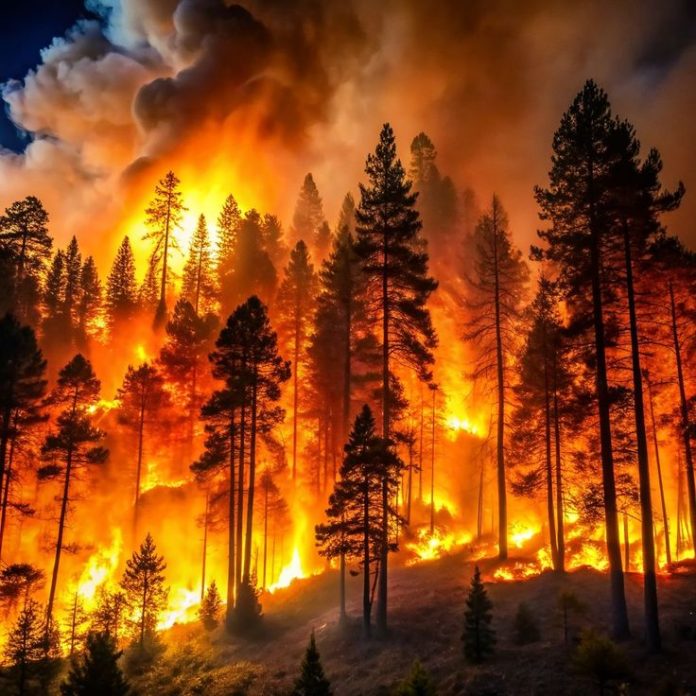Namibia has declared the week-long wildfire that tore through Etosha National Park to be contained, but officials caution that containment marks the beginning of a long recovery, not its end. The blaze, which the country’s environment ministry says began at a charcoal-production site beyond the reserve’s boundary, raced through dry grass and scrub under strong winds and pushed both into the protected area and across adjacent communal grazing lands. The Namibian government mobilized helicopters, water trucks, firefighters, police, volunteers and more than 500 troops to support suppression efforts while aerial photography is used to map the full extent of damage.
Etosha National Park covers 22,935 square kilometers and sustains 114 mammal species along with hundreds of migratory birds, including seasonal flocks of flamingos on the park’s salt pan. Officials estimate that roughly 30 percent of the park’s grazing has been destroyed. In practical terms that is on the order of 6,880 square kilometers, about 688,000 hectares, of pasture and habitat rendered unusable in the short term. Those hectares are not abstract numbers: they include waterpoints and seasonal corridors that underpin migrations and the survival of plains species as well as the small, locally important populations of black rhinos that conservation teams monitor closely.

So far the immediate human toll has been recorded as zero, but wildlife losses are already evident, at least nine antelope were found dead, and the ecological consequences will compound over months and seasons. Fire strips away cover and fodder, displacing survivors into smaller refuges where competition for food intensifies and disease risk increases. Predator–prey relationships shift when species move or mortality spikes, and small or fragmented populations such as Etosha’s rhinos face heightened long-term extinction risk if repeated habitat shocks become the norm. The loss of habitat also weakens the park’s ability to act as a seed bank and drought buffer for surrounding rangelands.
Read also: Meat production responsible for 60% of food emissions, yet rarely covered in climate news
For pastoral households around Etosha the blaze is an acute economic crisis. Authorities report that hundreds of thousands of hectares of grazing beyond the park were also consumed. Herders therefore face immediate and painful choices: sell livestock at depressed prices, buy costly supplementary feed, or undertake long, costly moves to find pasture and water farther afield. Concentrating herds at fewer water points and remaining grazing areas raises veterinary risks and reduces per-animal productivity, squeezing household incomes and food security across affected communities.
The blow to tourism will amplify those socioeconomic ripples. Etosha draws roughly 200,000 visitors a year and anchors a regional hospitality economy of lodges, guides, transport operators and local suppliers. Reduced game sighting, temporary closures of affected zones and the visual impact of charred landscapes will depress occupancy and receipts at businesses that often operate with slim margins. The decline in visitor revenue will feed back into municipal finances and employment, complicating recovery in towns that depend on seasonal tourism.
That the fire is suspected to have started at a charcoal site exposes a difficult policy trade-off. Charcoal production offers immediate cash for many rural families, yet informal and poorly regulated production accelerates woodland degradation and creates ignition risks when kilns and burn piles are poorly managed. Practical responses therefore need to move beyond blanket bans. Short-term restrictions on high-risk operations near parks must be combined with medium-term measures to formalize the charcoal value chain, introduce more efficient kilns that reduce wood demand, provide alternative livelihood pathways, and offer market linkages for sustainably produced charcoal where feasible.
Etosha’s blaze is also symptomatic of a shifting fire regime across the region. Warmer, drier seasons and episodic strong winds expand the windows for large fires, shrinking the margin for safe suppression. The transboundary nature of smoke and pasture loss, with fires spreading toward regions bordering Angola, highlights the necessity of regional coordination on air-quality monitoring, shared suppression assets and cross-border restoration planning. A strictly national response will not fully address the reality of landscape fire in a connected ecosystem.
Rehabilitation will be measured in seasons rather than weeks. Rangeland recovery in arid savannahs is slow: soils must stabilize, perennial grasses and shrubs often need multiple growing cycles to re-establish, and infrastructure such as water points, fencing and patrol roads will require repair. Effective recovery will rely on aerial mapping to prioritize interventions, seed and seedling programs to accelerate vegetation regrowth, veterinary support for affected herds, intensified anti-poaching patrols while wildlife is concentrated, and livelihood assistance such as cash-for-work schemes that reduce fuel loads and provide immediate income to households. These actions require predictable, multi-year financing rather than episodic emergency spending.
Read also: Another delay in EU forest law raises questions for Africa’s Cocoa and Coffee farmers
There are clear policy lessons for Namibia and countries across southern Africa. Integrated fire management, which combines satellite early-warning systems, trained community fire brigades, ecologically informed prescribed burning and rapid-response logistics, reduces the odds of megafires when consistently resourced. Complementary investments in community nurseries, sustainable charcoal pilots and contingency funds or micro-insurance for pastoralists can reduce ignition pressure while spreading the economic burden of prevention and restoration.
The choices Namibia makes in the coming months, how it sequences rehabilitation, funds pastoral relief, formalizes risky value chains and invests in fire-wise landscapes, will determine whether Etosha’s blackened plains become a recoverable chapter in a long conservation history or the opening scene of more frequent, costly wildfires across a warming, drying region. That practical test unites conservation, livelihoods and tourism: rebuild the systems that sustain communities and wildlife, and the park’s recovery will be possible; delay the structural reforms, and the cost in lost biodiversity and livelihoods will only compound.
Red also: Civil Society unveils priority actions to curb deforestation finance ahead of COP30





